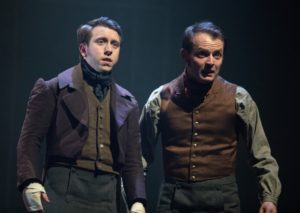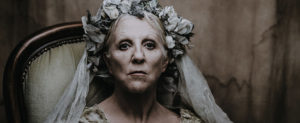 (3 / 5)
(3 / 5)
To be familiar with a narrative can sometimes evoke the desire for a fresh perspective. Yet even as one anticipates the events of a classic literary text such as Great Expectations, another member of the audience might be encountering it for the first time. Therefore, ideally, the adaptation must stay true to the original whilst offering something unique. To this end, I would say that Tilted Wig Productions have done a fine job in breathing new life into one of Charles Dickens’ most famous stories. And they have done this particularly well through the use of music, costume and set design.
For my companion, this would be his third theatre production of Great Expectations. This, alongside the viewing of many film and TV adaptations from down the years (his particular favourite being the 1989 production, which notably starred Anthony Hopkins as Magwitch), obliged me to ask for his humble opinion after the show. One of the most striking features for him -indeed for me too – was the simplicity of the set. Compromising a three-dimensional, metal-framed box, with a wooden-slatted wall across the back, and two sloping platforms to the front and right, this was a very basic stage. One of the advantages of such a rudimentary set-up was that it enabled the fluid movement of the actors. Another advantage was the ability to transition seamlessly between scenes. It is no mean feat to take on a narrative of such scope, with its broad array of settings, and recreate such different worlds in such a limited space. With the creative use of lighting, director Sophie Boyce Couzens and her team manage to do so, and with seemingly relative ease. We were both mightily impressed by the scale of this production.
One of the shows that this production evoked for me was the National Theatre’s Jane Eyre. In some senses, Great Expectations was essentially a miniature version of this. Both the set and the use of folk music are employed in similar ways, but on a much smaller scale in Great Expectations. Yet the quality is on a similar par. In terms of folk music, there may only be one musician in the cast of Great Expectations, but composer and performer Ollie King manages to evoke such realism with his accordion that no further instrumentation is needed. With a few simple notes, he creates an atmosphere, evokes a setting, and produces an emotion. It is an incredible skill for which he deserves all recognition. Alongside King’s music, there were also some interesting sound effects produced by the other actors, using a plethora of everyday objects shelved on one side of the set. These diegetic additions wonderfully complimented the action on stage, adding to the atmosphere and setting brilliantly. Again, simplicity was a striking feature in the use of sound. And for this production, simplicity becomes a mark of its quality.
Finally, I would like to nod handsomely to the costume makers. With most of the actors playing multiple parts, the choice of a base layer of clothing for each of them, onto which one or two items can be slipped on and off at each turn, allows for maximum flexibility, contributing to the seamless transition between scenes that I have already noted. Moreover, the transformation of Pip (Sean Aydon) from a blacksmith’s apprentice to young gentleman of the city is profoundly simple. It requires only the buttoning up of his jacket, the addition of a coat, top hat and bag, to completely change the character’s social class. I couldn’t believe the effectiveness of such minimal changes. The piece de resistance however, has to be the wedding dress of Miss Havisham (Nichola McAuliffe). It is glorious in its tapestry, magical in its setting, and beautifully faded to reflect the character’s frozenness in time. It perfectly matches the commanding and slightly offbeat performance of McAuliffe. Considering the anticipation that came with this – Miss Havisham is my favourite character in Great Expectations, and one of my favourites in Dickens’ collection – it certainly didn’t disappoint.
Overall, Tilted Wig Productions, in association with Malvern Theatres, have produced an adaptation of Great Expectations that is marked by simplicity. Yet this simplicity is not akin to low quality. The set may be basic, but it allows the actors a freedom to creatively engage in storytelling. The music may be stripped back, but it evokes atmosphere and emotion incredibly well. The costumes may be simple, but the ability to transform characters by the drop of a hat or the fitting of a jacket is extraordinary. They manage to achieve so much by keeping it so simple. It makes for a beautiful adaptation that finds that wealth is not the maker of a show. Instead, with a little bit of ingenuity, it is love that creates something truly special.
Click here for more info and tickets.



